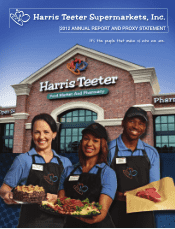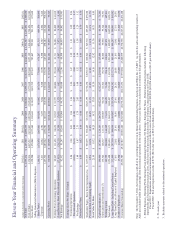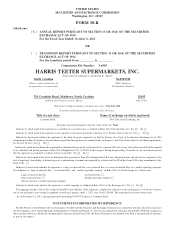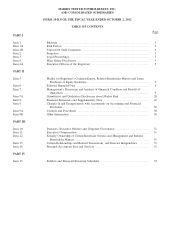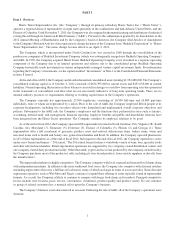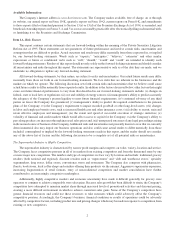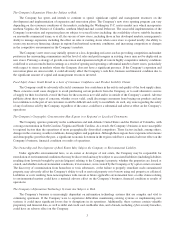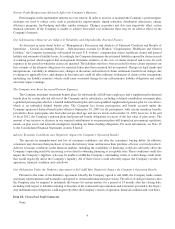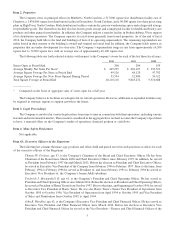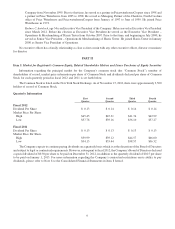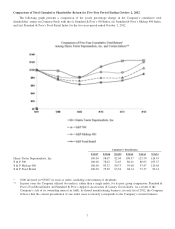Harris Teeter 2012 Annual Report Download - page 8
Download and view the complete annual report
Please find page 8 of the 2012 Harris Teeter annual report below. You can navigate through the pages in the report by either clicking on the pages listed below, or by using the keyword search tool below to find specific information within the annual report.Narrow Profit Margins may Adversely Affect the Company’s Business.
Profit margins in the supermarket industry are very narrow. In order to increase or maintain the Company’s profit margins,
strategies are used to reduce costs, such as productivity improvements, shrink reduction, distribution efficiencies, energy
efficiency programs, fuel hedging and other similar strategies. Changes in product mix also may negatively affect certain
financial measures. If the Company is unable to achieve forecasted cost reductions there may be an adverse effect on the
Company’s business.
Our Self-Insurance Reserves are Subject to Variability and Unpredictable External Factors.
As discussed in more detail below in “Management’s Discussion and Analysis of Financial Condition and Results of
Operations – Critical Accounting Policies – Self-insurance accruals for Workers’ Compensation, Healthcare and General
Liability,” the Company is primarily self-insured for most U.S. workers’ compensation claims, healthcare claims and general
liability and automotive liability losses. Accordingly, the Company determines the estimated liability required for claims in each
accounting period, which requires that management determine estimates of the costs of claims incurred and accrue for such
expenses in the period in which the claims are incurred. The liabilities that have been recorded for these claims represent our
best estimate of the ultimate obligations for reported claims plus those incurred but not reported. Changes in legal trends and
interpretations, variability in inflation rates, changes in the nature and method of claims settlement, benefit level changes due
to changes in applicable laws, and changes in discount rates could all affect ultimate settlements of claims or the assumptions
underlying our liability estimates, which could cause a material change for our self-insurance liability obligations and could
adversely impact earnings.
The Company may Incur Increased Pension Expenses.
The Company maintains retirement benefit plans for substantially all full-time employees and a supplemental retirement
benefit plan for certain selected officers of the Company and its subsidiaries, including a defined contribution retirement plan,
a qualified pension plan which is a funded defined benefit plan and a non-qualified supplemental pension plan for executives,
which is an unfunded defined benefit plan. The Company has frozen participation and benefit accruals under the
Company-sponsored defined benefit plan effective September 30, 2005 for all participants, with certain transition benefits
provided to those participants who had achieved specified age and service levels on December 31, 2005; however, at the end
of fiscal 2012, the Company’s pension plans had projected benefit obligations in excess of the fair value of plan assets. The
amount of any increase or decrease in our required contributions to our pension plans will depend on government regulation,
returns on plan assets and actuarial assumptions regarding our future funding obligations. For more information, see Note 15
to the Consolidated Financial Statements in Item 8 hereof.
Adverse Economic Conditions may Negatively Impact the Company’s Operating Results.
The increase in unemployment and loss of consumer confidence can alter the consumers’ buying habits. In addition,
consumers may decrease their purchases of more discretionary items and increase their purchase of lower cost food products.
Adverse economic conditions in the financial markets, including the availability of financing, could also adversely affect the
Company’s operating results by increasing costs related to obtaining financing at acceptable rates. These conditions could also
impact the Company’s suppliers, who may be unable to fulfill the Company’s outstanding orders or could change credit terms
that would negatively affect the Company’s liquidity. All of these factors could adversely impact the Company’s results of
operations, financial condition and cash flows.
Our Obligations Under the Definitive Agreement to Sell A&E May Negatively Impact the Company’s Operating Results
Pursuant to the terms of the definitive agreement whereby the Company agreed to sell A&E, the Company made certain
customary representations and warranties and agreed to certain indemnification provisions. The effect of such provisions is that
the Company may be required to indemnify the buyers for certain matters for a period of 18 months after the closing date,
including with respect to liabilities relating to breaches of the contractual representations and warranties provided to the buyers.
Any indemnification obligations could negatively affect the Company’s results of operation, financial condition and cash flows.
Item 1B. Unresolved Staff Comments
None.
4

